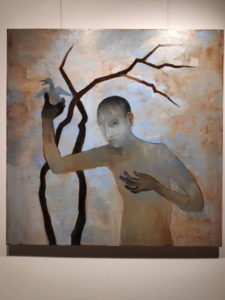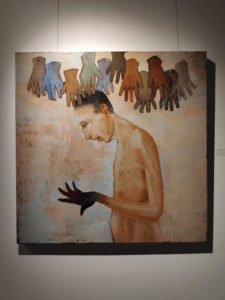The art of untitled: Alan Vance brings his work to MC campus
 If you have walked through Clayton Center for the Arts Building B this January, you have probably caught a glimpse of a faceless woman in striking orange or a man with dozens of fingered gloves dangling over his head. These are some of the subjects of a collection of paintings by Alan Vance, whose art was on display in the Blackberry Farms Gallery throughout the month of January.
If you have walked through Clayton Center for the Arts Building B this January, you have probably caught a glimpse of a faceless woman in striking orange or a man with dozens of fingered gloves dangling over his head. These are some of the subjects of a collection of paintings by Alan Vance, whose art was on display in the Blackberry Farms Gallery throughout the month of January.
The College was fortunate enough to welcome Vance to our campus on Friday, Jan. 25 to talk about his work. Vance considers himself a “prolific sketchbook guy,” and many of his paintings came from piecing together repetitive elements from his sketches.
Indeed, with just a quick walk around the gallery, one could see that gloves, baskets, tree branches, and birds are common objects of his collection. Vance stated that the gloves were reminiscent of his hometown farm in Kentucky, but other than that, the paintings do not hold deep meanings. This absence of meaning, however, was intentional.
“Just don’t think too much,” Vance said. “Without an intended meaning the paintings are freer to speak for themselves. I would rather make people feel something undefinable, than contrive a meaning for the painting after it’s already finished.”
The viewing of art is always a subjective experience for every individual, and Vance hopes to enhance this personal experience by leaving his paintings untitled, thus leaving the viewer free to interpret the art without preconceptions. He wants people to bring their own baggage to the paintings and pull something out of the art that is meaningful to them. 
As for Vance’s personal experience in the creation of his collection, which took around five months to complete, he adopted the same motto he had for viewing the art: “Just don’t think too much.” He admitted to “overworking” the first piece of art in the collection, which was a basket full of baby birds with hungry, open mouths.
He found himself painting layer after layer on the canvas and eventually felt that he had “painted the art right out of it.” For the remaining paintings in his collection, he resolved to focus on the process instead of obsessing over the end product.
To avoid overworking one painting, Vance would work on five or six paintings at a time. This explains the cohesive color scheme of antique blues and rusty oranges throughout the collection. His primary medium was oil paint, which, because it takes multiple days to dry, is easily workable and allowed him to switch between paintings without worrying about them drying out.
He experimented with mixing the paint with turpentine, which is a solvent used for thinning oil paint, and varnish that gives paint a shiny finish. The effects of these two materials can be seen in the translucent, faded colors and smooth, shiny texture of his works.
For Vance, the process of creation was cathartic. He would work mostly in silence, or listen to a well-loved TV show in the background while he worked.
He laughed when saying his painting time “was a time to reminisce and relive arguments from twenty years ago.” Because he was not bent on expressing a profound meaning in any of his paintings, he felt free to play with consistency and texture and enjoyed the simple act of balancing forms and blending shapes together on a canvas.
As students of Maryville College, we have a unique opportunity with the Clayton Center galleries to view new art all throughout the year. If you missed the Jan art reception, don’t worry! The next reception for artists whose work is displayed on campus will be Feb. 25 from 6 p.m. to 8 p.m.
